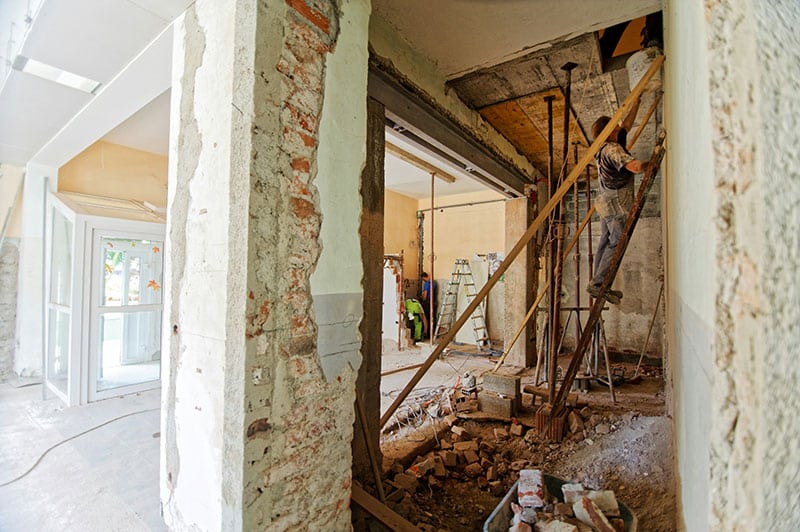What is retrofitting? And why is asbestos awareness important during the retrofitting of a UK home?
While energy bills have been a particular topic of concern among UK homeowners over the last few years, the importance of retrofitting existing residential properties goes much deeper than acute financial concerns. After all, it relates closely to the long-term protection of our planet.
This much has been recognised by UK Government initiatives. In March 2023, for example, the Department for Energy Security and Net Zero (DESNZ) announced the award of £1.8 billion through the Social Housing Decarbonisation Fund, the Home Upgrade Grant, and the Public Sector Decarbonisation Scheme, geared towards upgrading social homes and public buildings.
With much of the UK housing stock dating to the early-to-mid 20th century or earlier, it is fair to say that many older residential properties up and down the country could benefit greatly from retrofitting to help improve their energy efficiency.
However, if your own residential property in the UK – or such a building that you are responsible for maintaining – dates from before the year 2000, there is at least one other risk that you must be mindful of: the potential presence of asbestos. This now-notorious carcinogen was once widely used in UK construction, and the use of all forms of asbestos in this country was only finally banned in 1999.
You will need to be aware of various issues if you are looking to retrofit your domestic property, and the importance of safely managing asbestos might be one of them. So, in this article, we have taken a closer look at the essentials to know.
What is retrofitting?
The term “retrofitting” refers to the practice of carrying out upgrades to a property – such as a home – to improve its energy efficiency. Such improvement work helps to make the given building easier to heat, while boosting its ability to retain heat for longer, and transitioning the property from dependence on fossil fuels to the use of renewable energy.
On the backdrop of the intensifying climate crisis, as well as the need to minimise energy costs, the owners of residential properties up and down the UK are increasingly looking to implement energy-saving improvements.
Examples of such retrofitting include the replacement of windows, the upgrading of insulation, and the installation of more efficient heating, ventilation, and air conditioning (HVAC) systems.
Why is asbestos common in older UK homes?
A naturally occurring fibrous silicate mineral, asbestos began to be commercially mined in the middle of the 19th century. It was the 20th century, however, that ultimately came to be the UK’s “asbestos century”.
Asbestos was found to be mechanically strong, as well as resistant to heat and fire, and an effective insulation material. With this mineral also being relatively affordable and easy to obtain, it went on to be incorporated into all manner of building products that found their way into UK homes, such as asbestos cement roofs, sprayed coatings, loose fill insulation, and vinyl floor tiles, to cite just a few examples.
As the decades passed, however, it became widely recognised that the inhalation or ingestion of asbestos fibres – as could be easily released from many asbestos-containing materials (ACMs) – heightened the risk of the exposed individual developing a potentially fatal health condition.
Such increasing awareness of the risks led to ever-tightening legal restrictions on the use of asbestos in the UK, culminating in the substance in all its types being banned altogether in late 1999.
What are the dangers of asbestos exposure during retrofitting?
Over the years, asbestos exposure has often happened due to the ACMs in a given property being disturbed. Such disturbance can cause loose asbestos fibres to be released, and to be subsequently breathed in and lodged in the lungs.
The swallowing or breathing-in of asbestos does not have an immediate adverse health effect. In fact, it typically takes anywhere between around 10 years and 50 years for an exposed individual to show physical symptoms of an asbestos-related disease such as mesothelioma, asbestos-related lung cancer, or asbestosis.
Of course, it is worth noting as well, that the mere fact of someone breathing in asbestos does not automatically mean they will develop an asbestos-related disease.
Nonetheless, the risks posed by asbestos to human health need to be taken extremely seriously. Even in the 2020s, approximately 5,000 deaths a year in the UK are attributable to asbestos-related health conditions.
Any projects liable to disrupt a building’s fabric – including retrofitting tasks such as the replacement of insulation and the installation of heating and hot water systems – can potentially cause disturbance to any ACMs still in the property dating back to before the 1999 ban.
After all, such projects are likely to involve inherently disruptive activities like drilling, cutting, and even potentially elements of demolition.
How can I identify asbestos in my home before starting retrofitting?
We have written previously about various aspects of what asbestos looks like, and the indicators that might help you to spot suspected ACMs in your home. However, we would also strongly emphasise that the only way you can definitively confirm a particular material in your property to be asbestos, is if you arrange for a professional asbestos survey.
Unlike the situation for non-domestic properties such as schools, hospitals, and offices, it isn’t a strict legal requirement to have an asbestos survey carried out at a residential property.
However, there are a few caveats to this; the UK’s Control of Asbestos Regulations 2012 (CAR 2012), which form the country’s overarching asbestos legislation, do apply to the “common areas” of certain domestic premises, such as the foyers, staircases, and lifts in blocks of flats.
It is also important to know about the distinctions between the different types of asbestos survey, so that you request the most suitable one for your property and situation. The two principal types are (1) management surveys, which apply during the normal use and management of the given property, and (2) refurbishment or demolition surveys.
The latter type of asbestos surveys are the most intrusive ones. However, precisely because of this intrusiveness, they can also provide thorough results making clear the true asbestos situation at your property. This, in turn, could be greatly reassuring if you intend to have extensive retrofitting work carried out.
What should I do if asbestos is found in my home?
One other very good reason to arrange to have an asbestos survey carried out at your residential property prior to retrofitting works, is the fact that you won’t only learn about what asbestos may be present in the building, and associated information including the location(s), amount(s), and condition of such materials.
Indeed, once the survey is complete, you can expect to be issued with a comprehensive asbestos report. This document will set out the aforementioned information, complete with photographs. Alongside this, however, the report will outline recommendations as to how you can safely manage any ACMs the surveyor found to be present.
Depending on the risk that any discovered ACMs are judged to present – including if retrofitting work is set to take place at the property – you may ultimately decide to have those materials encapsulated. This would involve the materials effectively being “sealed off” to prevent any disturbance or the release of loose asbestos fibres in the future.
Alternatively, you may favour having the ACMs entirely removed from your home. You might opt for this if the asbestos materials are severely damaged or deteriorated, or if their location puts them at particularly high risk of future disturbance.
If you do decide to arrange for removal of the ACMs from your property, you should make sure you choose reputable and licensed asbestos removal contractors to take on this specialised task.
What are the legal requirements for managing asbestos during retrofitting in the UK?
As we touched upon above, it can be easy to become confused about where the legal responsibilities fall in relation to asbestos as far as domestic properties are concerned.
If you are a homeowner living in your own domestic property in Great Britain, and you have arranged for contractors to undertake retrofitting work in the building, you won’t be legally responsible for the risks that any ACMs in your property might pose to such workers. This is because, as the property owner, you won’t be engaged in any work activity yourself.
Instead, it will be the responsibility of the contractor – when they are carrying out retrofitting or other work in a domestic property – to ensure adherence to the UK’s asbestos regulations. This will be of critical importance for ensuring not only their own safety, but also that of the homeowner and any other occupants and users of the building.
The Health and Safety at Work etc Act 1974, Section 3(1), sets out general duties that further help protect homeowners from any risks that may be posed to them as a consequence of work undertaken in their homes.
How do I ensure safety during the retrofitting process?
To reiterate what we stated above: if you are a homeowner living in your own domestic property, it will be the responsibility of any visiting contractors – rather than your own duty – to ensure safety during the retrofitting process in your home.
Nonetheless, working closely with such contractors, there are still certain safety measures that you may look to plan and implement. These could include:
- Maintaining open communication between yourself, any retrofitting contractors, and any asbestos professionals who carry out projects such as surveying, encapsulation, and/or removal of ACMs at your property
- Asking the contractor about any steps they are taking to protect themselves and occupants of your property, such as containment and air monitoring
- Formulating, implementing, and following a comprehensive asbestos management plan
- Arranging for temporary relocation from your property during asbestos works and/or retrofitting projects, if this is judged to be necessary
- Ensuring any work areas are suitably contained and well-ventilated
- Making sure that – if asbestos has been removed from the building – post-removal inspection and air quality testing have been carried out, in order to confirm safety prior to reoccupation.
Conclusion: it is crucial to be alert to potential asbestos risks when retrofitting
We have hopefully made clear in this guide, that you must understand the scope for asbestos risks to arise in your UK residential property if you intend retrofitting work to take place there.
By taking advantage of the professional expertise of licensed and accredited asbestos experts, and ensuring your chosen contractors adhere to all relevant regulations, you can greatly help make sure that any retrofitting project at your home is executed successfully and safely.
If you are interested in learning more about how our asbestos services at Oracle Solutions can assist you in achieving such goals for your property’s retrofitting, please don’t hesitate to contact us. We can provide you with impartial advice, as well as a fast and free quote.

Written by Mark Carter
Mark Carter is a renowned expert in asbestos management, offering clients vital guidance on compliance and safety. His expertise is invaluable for navigating asbestos regulations, ensuring both safety and legal adherence. Mark's role is central in providing effective asbestos-related solutions, helping clients achieve their business objectives with an emphasis on regulatory compliance and safety in asbestos management.


